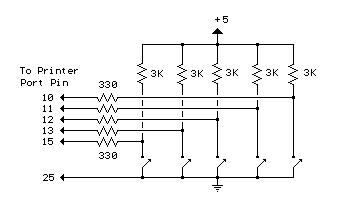 by Tomi Engdahl on Tue Nov 29, 2005 2:15 pm
by Tomi Engdahl on Tue Nov 29, 2005 2:15 pm
Read this document for information on interfacing to parallell port:
http://www.epanorama.net/circuits/paral ... html#input
Parallel port has five input pins that that can be used to interface switches:

If you select sensors that have free floating relay output contacts, then you can put this contact in place of the switch on this circuit. Should work on reasonably short cables (several meters) very nicely (with long cables there is potential for interference because parallel port os quite sensitive).
If the sensors have voltage output, open collector output or are located some distance away, the safest choise would be to put a relay or optocoupler between he sensor and PC. The sensor signa activates that relay/optocoupler control side, and the output of it goes to parallel port circuit in place of the switch.
Those same idas can be also adapted for use with PC joystick port button inputs) or serial port (modem status inputs).
Read this document for information on interfacing to parallell port:
http://www.epanorama.net/circuits/parallel_output.html#input
Parallel port has five input pins that that can be used to interface switches:
[img]http://www.epanorama.net/circuits/parallel_input.gif[/img]
If you select sensors that have free floating relay output contacts, then you can put this contact in place of the switch on this circuit. Should work on reasonably short cables (several meters) very nicely (with long cables there is potential for interference because parallel port os quite sensitive).
If the sensors have voltage output, open collector output or are located some distance away, the safest choise would be to put a relay or optocoupler between he sensor and PC. The sensor signa activates that relay/optocoupler control side, and the output of it goes to parallel port circuit in place of the switch.
Those same idas can be also adapted for use with PC joystick port button inputs) or serial port (modem status inputs).